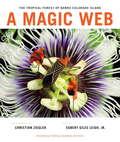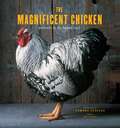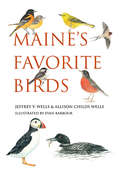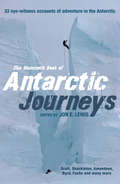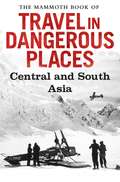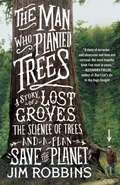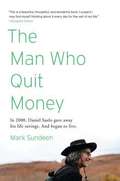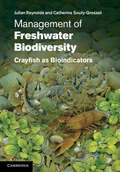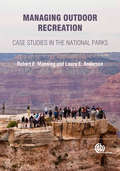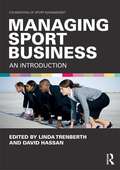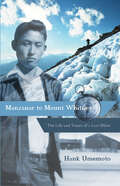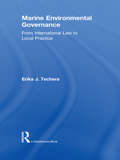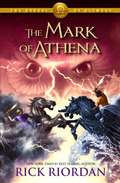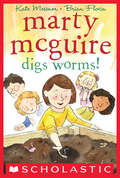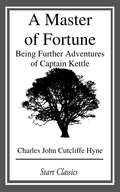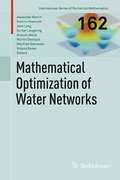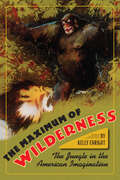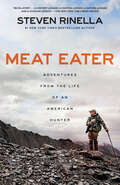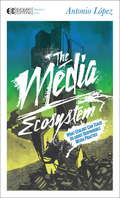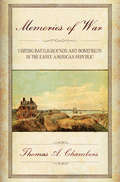- Table View
- List View
A Magic Web
by Christian Ziegler Egbert Giles LeighThe tropical forest of Panama's Barro Colorado Island is a luxuriant community of plants and animals, pulsating with life and offering an astonishing view of nature's myriad processes. What does the forest look like? How do the activities of the forest's plants and animals create a community?In A Magic Web, photographer Christian Ziegler and evolutionary biologist Egbert Giles Leigh, Jr., invite readers to enter the marvelous world of Barro Colorado Island. This book is a unique combination of spectacular photography and clear, authoritative text written by an active scientist who has spent half a lifetime trying to understand the tropical forest. Luscious photographs of the forest reveal the wonderful diversity of its inhabitants and show many of the activities that give it its character and lend structure to its community. Drawing on decades of work on Barro Colorado Island, Egbert Leigh explains how the forest works: how plants and animals compete with but also depend on each other; how the solitary lives of cats contrast with the intricately organized lives of armies of ants; the variety of ways plants struggle for a place in the sun; and how these plants attract animals to pollenate their flowers. Finally, the book shows the importance of tropical forests to the people living near them, why they matter to the world at large, what we can learn from them, and how they differ from temperate-zone forests.Full of stunning full-color photographs accompanied by clear and accessible text, A Magic Web is a must for anyone planning to visit a tropical forest and for all those who wish they could.
The Magnificent Chicken
by Tamara StaplesWith backyard chicken keeping and urban farming at an all-time high, the proudest of purebred poultry take center stage once again in this fully revised and expanded edition of the classic The Fairest Fowl, now retitled The Magnificent Chicken. Updated with even more chickens and an enlarged resource section, this celebration of the wonder, peculiarity, and magnificence of championship chickens showcases more than 40 astonishing breeds in glamorous photos--many brand new--and informative text, while an introduction by Ira Glass explores the finer points of poultry shows and chicken portraiture.
Maine's Favorite Birds
by Evan Barbour Jeffrey V. Wells Allison Childs WellsFrom lush forests and rocky coastlines to lakes, mountains, and rolling fields, spectacular natural beauty and diverse habitats make Maine a wonderful place for seeing and hearing some of North America's most iconic birds. This fresh new book highlights the birds that are loved by Mainers and essential to why millions of tourists visit each year. Written by well-known birders and native Mainers, and based on their years of experience answering questions, leading bird walks, and teaching people about birds, Maine's Favorite Birds puts the focus on Maine's most-loved and best-known birds. This makes the book uniquely suited to bird enthusiasts who want to identify and learn more about the birds around them without the expense and confusion of more advanced field guides. Maine's Favorite Birds features each bird beautifully illustrated in large format, accompanied by clear and concise identification tips, habitat references, and easy-to-remember song descriptions. It also includes birding hot spots and ways birders can put their observations to use for science and conservation. Maine's Favorite Birds is perfect for everyone from kids to grandparents, parents to teachers, Mainers and tourists alike anyone who wants to know and better appreciate the birds they see in backyards, parks, wild areas, and nature preserves.
Make a Wish Bear
by Greg FoleyA friendship book perfect for the holiday season One clear night, Bear makes a wish on a twinkling star and Mouse joins him in waiting for the wish to come true. But the other animals who come by all have advice for Bear. "Don't tell anyone," says Owl. "Close your eyes," says Fox. And Elephant suggests standing on one foot. Before long, all of Bear's friends are there. "What did you wish for?" asks Mouse. Bear's answer will bring a smile to even the very youngest readers. Simply told and wonderfully illustrated, Make a Wish Bear reminds readers what's most important in life--good friends.
The Mammoth Book of Antarctic Journeys: 32 eye-witness accounts of adventure in the Antarctic
by Jon E. LewisThe very best writing on the Antarctic, from James Cook's eighteenth-century assertion that 'no man will ever venture further than I have done' to Lynne Cox's description of her epic, icy swim in the twenty-first century - 32 first-hand accounts of men and women challenging one of the Earth's last true wildernesses. Here you will find both legendary tales of heroism and startling contemporary accounts of the impact of global warming on the Earth's sole undeveloped continent, including: 'Dog Days' by Robert Falcon Scott. 'The Loss of the Endurance' by Ernest Shackleton. 'Alone' by Richard E Byrd .'The Killer under the Water' by Gareth Wood. 'Melting Point' by David Helvarg. 'Swimming to Antarctica' by Lynne Cox.
The Mammoth Book of Travel in Dangerous Places: Central and South Asia (Mammoth Books #349)
by John KeayAlarms amongst the Uzbeks - Alexander BurnesOf all the "forbidden" cities (Timbuktu, Mecca, Lhasa, Riyadh and so on) none enjoyed a more fearsome reputation that Bukhara in Uzbekistan. The first British Indian expedition, that of William Moorcroft in 1819-26, had never returned. Moorcroft's disappearance, like that of Livingstone or Franklin, posed a challenge in itself and preyed on the minds of his immediate successors. Heavily disguised and in an atmosphere of intense intrigue, Burnes and Dr James Gerard crossed the Afghan Hindu Kush in 1832 and approached the scenes of Moorcroft's discomfiture. They would both return; and "Bukhara Burnes" would become the most renowned explorer of his day.On the Roof of the World - John WoodIn 1937 Alexander Burnes returned to Afghanistan on an official mission. Amongst his subordinates was a ship's lieutenant who, having surveyed the navigational potential of the river Indus, took off on a mid-winter excursion into the unknown Pamirs between China and Turkestan. Improbably, therefore, it was John Wood, a naval officer and the most unassuming of explorers, who became the first to climb into the hospitable mountain heartland of Central Asia and the first to follow to its source the great river Oxus (or Amu Darya.)Exploring Angkhor - Henri MouhotBorn in France, Mouhot spent most of his career in Russia as a teacher and then in the Channel Islands. A philologist by training, he also took up natual history and it was with the support of the Royal Zoological Society that in 1858 he set out for South East Asia. From Siam (Thailand) he penetrated Cambodia and Laos, where he died; but not before reaching unknown Angkhor and becoming the first to record and depict the most extensive and magnificent temple complex in the world. His discovery provided the inspiration for a succession of subsequent French expeditions up the Mekong.Over the Karakorams - Francis Edward YounghusbandAs leader of the 1904-5 British military expedition to Lhasa and as promoter of the early assaults on Mount Everest, Younghusband came to epitomize Himalayan endeavour. To the mountain he also owed his spiritual conversion from gung-ho solider to founder of the World Congress of Faiths. His initiation came in 1887 when, as the climax to journey from Peking across the Gobi desert, he determines to reach India over the unexplored Mustagh Pass in the Karakorams - "the most difficult and dangerous achievement in these mountains so far" (S.Hedin).Trials in Tibet - Ekai KawaguchiBy the 1890's the capital of "forbidden" Tibet, unseen by a foreigner since Huc's visit, represented the greatest challenge to exploration. Outright adventurers like the dreadful Henry Savage Landor competed with dedicated explorers like Sven Hedin, all succumbed to to a combination of official vigilance and physical hardship. The exception, and the winner in "the race for Lhasa", was a Buddhist monk from Japan whose expedition consisted of himself and two sheep. Ekai Kawaguchi was supposedly a pilgrim seeking religious texts. His faith was genuine and often tested, as during this 1900 excursion into western Tibet; but he is also thought to have been an agent of the British government in India.
The Man Who Planted Trees: A Story of Lost Groves, the Science of Trees, and a Plan to Save the Planet
by Jim RobbinsTHIS BOOK JUST MIGHT SAVE THE PLANET "When is the best time to plant a tree? Twenty years ago. The second best time? Today."--Chinese proverb Twenty years ago, David Milarch, a northern Michigan nurseryman with a penchant for hard living, had a vision: angels came to tell him that the earth was in trouble. Its trees were dying, and without them, human life was in jeopardy. The solution, they told him, was to clone the champion trees of the world--the largest, the hardiest, the ones that had survived millennia and were most resilient to climate change--and create a kind of Noah's ark of tree genetics. Without knowing if the message had any basis in science, or why he'd been chosen for this task, Milarch began his mission of cloning the world's great trees. Many scientists and tree experts told him it couldn't be done, but, twenty years later, his team has successfully cloned some of the world's oldest trees--among them giant redwoods and sequoias. They have also grown seedlings from the oldest tree in the world, the bristlecone pine Methuselah. When New York Times journalist Jim Robbins came upon Milarch's story, he was fascinated but had his doubts. Yet over several years, listening to Milarch and talking to scientists, he came to realize that there is so much we do not yet know about trees: how they die, how they communicate, the myriad crucial ways they filter water and air and otherwise support life on Earth. It became clear that as the planet changes, trees and forest are essential to assuring its survival. The Man Who Planted Trees is both a fascinating investigation into the world of trees and the inspiring story of one man's quest to help save the planet. This book's hopeful message of what one man can accomplish against all odds is also a lesson about how each of us has the ability to make a difference. This book was printed in the United States of America on Rolland EnviroTM 100 Book, which is manufactured using FSC-certified 100% postconsumer fiber and meets permanent paper standards.From the Hardcover edition.
The Man Who Quit Money
by Mark SundeenIn 2000, Daniel Suelo left his life savings-all thirty dollars of it-in a phone booth. He has lived without money-and with a newfound sense of freedom and security-ever since. The Man Who Quit Money is an account of how one man learned to live, sanely and happily, without earning, receiving, or spending a single cent. Suelo doesn't pay taxes, or accept food stamps or welfare. He lives in caves in the Utah canyonlands, forages wild foods and gourmet discards. He no longer even carries an I. D. Yet he manages to amply fulfill not only the basic human needs-for shelter, food, and warmth-but, to an enviable degree, the universal desires for companionship, purpose, and spiritual engagement. In retracing the surprising path and guiding philosophy that led Suelo into this way of life, Sundeen raises provocative and riveting questions about the decisions we all make, by default or by design, about how we live-and how we might live better.
Management of Freshwater Biodiversity
by Catherine Souty-Grosset Julian ReynoldsIntegrating research into freshwater biodiversity and the role of keystone species, this fascinating book presents freshwater crayfish as representatives of human-exacerbated threats to biodiversity and conservation. It uses examples from these and other large decapod invertebrates to explore how communities function and are controlled, alongside the implications of human demands and conflicts over limited resources, notably the severe impacts on biodiversity. The discussion is structured around three key topics - the present situation of crayfish in world freshwater ecosystems, the applications of science to conservation management and knowledge transfer for successful crayfish management. It outlines the historic exploitation of crayfish, addressing the problems caused by invasive alien forms and explaining the importance of correct identification when dealing with conservation issues. Offering a global perspective on freshwater systems, the book ultimately highlights how the conservation of such large and long-lived species will help protect ecosystem quality in the future.
Management of Freshwater Biodiversity
by Julian Reynolds Catherine Souty-Grosset Keith CrandallIntegrating research into freshwater biodiversity and the role of keystone species, this fascinating book presents freshwater crayfish as representatives of human-exacerbated threats to biodiversity and conservation. It uses examples from these and other large decapod invertebrates to explore how communities function and are controlled, alongside the implications of human demands and conflicts over limited resources, notably the severe impacts on biodiversity. The discussion is structured around three key topics - the present situation of crayfish in world freshwater ecosystems, the applications of science to conservation management and knowledge transfer for successful crayfish management. It outlines the historic exploitation of crayfish, addressing the problems caused by invasive alien forms and explaining the importance of correct identification when dealing with conservation issues. Offering a global perspective on freshwater systems, the book ultimately highlights how the conservation of such large and long-lived species will help protect ecosystem quality in the future.
Managing Climate Change Business Risks and Consequences: Leadership for Global Sustainability
by James A. F. Stoner Charles Wankel Neil Washington Matt Marovich Kyle MillerAlthough the title of this volume and its major focus will be on one major aspect of global sustainability - climate change - this volume continues with the overall framing of the series: global sustainability is a multi-faceted, global, multi-generational, economic, social, environmental, and cultural phenomenon and challenge to our species.
Managing Outdoor Recreation
by Laura E Anderson Robert E ManningThe popularity of outdoor recreation and ecotourism continues to grow worldwide. However, there is little systematic information on how to manage outdoor recreation in ways that protect park resources and the quality of the visitor experience. This book develops classification systems of outdoor recreation-related problems and management strategies and practices and combines them into a series of matrices that can help guide park and outdoor recreation management. The book then uses a series of case studies drawn from the U.S. National Park System that illustrate a range of successful management approaches that can be applied globally. The book concludes with a series of principles for managing parks and outdoor recreation.
Managing Sport Business: An Introduction
by David HassanContemporary sport is both a sophisticated and complex international business and a mass participatory practice run largely by volunteers and community organizations. This authoritative and comprehensive introduction to the theory and practice of sports management helps to explain the modern commercial environment that shapes sport at all levels and gives clear and sensible guidance on best practice in sports management, from elite sport to the local level. The book is divided into three sections. The first examines the global context for contemporary sports management. The second explores the key functional areas of management, from organization and strategy to finance and marketing, and explains how successful managerial techniques can be applied in a sporting context. The final section surveys a wide range of important issues in contemporary sports management, from corporate social responsibility to the use of information and communication technologies. Together, these sections provide a complete package of theory, applied practical skills and a state-of-the-art review of modern sport business. With useful features included throughout, such as chapter summaries and definitions of key terms, and with each chapter supported with real-world data and examples, this book is essential reading for all students of sport management and sport business.
Managing the Risks of Extreme Events and Disasters to Advance Climate Change Adaptation
by Christopher B. Field Vicente Barros Thomas F. Stocker Qin DaheThis Intergovernmental Panel on Climate Change Special Report (IPCC-SREX) explores the challenge of understanding and managing the risks of climate extremes to advance climate change adaptation. Extreme weather and climate events, interacting with exposed and vulnerable human and natural systems, can lead to disasters. Changes in the frequency and severity of the physical events affect disaster risk, but so do the spatially diverse and temporally dynamic patterns of exposure and vulnerability. Some types of extreme weather and climate events have increased in frequency or magnitude, but populations and assets at risk have also increased, with consequences for disaster risk. Opportunities for managing risks of weather- and climate-related disasters exist or can be developed at any scale, local to international. Prepared following strict IPCC procedures, SREX is an invaluable assessment for anyone interested in climate extremes, environmental disasters and adaptation to climate change, including policymakers, the private sector and academic researchers.
Manzanar to Mount Whitney: The Life and Times of a Lost Hiker
by Hank UmemotoIn 1942, fourteen-year-old Hank Umemoto gazed out a barrack window at Manzanar Internment Camp, saw the silhouette of Mount Whitney against an indigo sky, and vowed that one day he would climb to the top. Fifty-seven years and a lifetime of stories later, at the age of seventy-one, he reached the summit. Part memoir and part hiker's diary, Manzanar to Mount Whitney gives an intimate, rollicking account of Japanese American life California before and after World War II. As he wanders through the mountains of California's Inland Empire, Umemoto recalls pieces of his childhood on a grape vineyard in the Sacramento Valley, his time at Manzanar, where beauty and hope were maintained despite the odds, and his later career as proprietor of a printing firm, all with grace, honesty, and unfailing humor. And all along, the peak of Mount Whitney casts its shadow, a symbol of freedom, beauty, and resilience.
Marine Environmental Governance: From International Law to Local Practice
by Erika TecheraMarine Environmental Governance: From International Law to Local Practice considers the relationship between international environmental law and community-based management of marine areas. Focusing on small island states, in which indigenous populations have to a large extent continued to maintain traditional lifestyles, this book takes up the question of how indigenous customary law and state-based legislation can be reconciled in the implementation of international environmental law. Including a range of case studies, as well as detailed comparative analysis, it pursues an interdisciplinary approach to legal pluralism 'in practice' that will be of considerable interest to environmental lawyers, legal anthropologists, conservation biologists and those working in the area of community-based conservation.
The Mark of Athena (The Heroes of Olympus #3)
by Rick RiordanThe Greek and Roman demigods will have to cooperate in order to defeat the giants released by the Earth Mother, Gaea. Then they will have to sail together to the ancient land--Greece itself--to find the Doors of Death.
The Marksmanship Primer: The Experts' Guide to Shooting Handguns and Rifles
by Jim CasadaThe Marksmanship Primer serves as a roadmap to greater shooting proficiency as well as greater enjoyment of the sport of shooting. Jim Casada, renowned outdoors author and editor, has brought together the best selections from America's great gun writers of yesterday and today. Marksmen of all levels of experience—beginners, pros, and hobbyists—can benefit from this collection of shooting wisdom.Topics include:Positions for Rifle and Handgun ShootingSighting InBallisticsRifle Marksmanship for the HunterAccuracy at All DistancesHunting with the HandgunPhysical and Mental Fitness for the MarksmanAchieving accuracy and a high degree of competence is an immediate joy; refining it through regular trips to the range or the field can provide a lifetime of pleasure. The Marksmanship Primer is the best book to seek hunting and target shooting knowledge.
Marty McGuire Digs Worms!
by Kate Messner Brian FlocaAn irrepressible third grader’s school project to help the planet causes chaos instead in this funny, accessible chapter book.Marty McGuire’s third-grade class has a special assignment: Save the Earth! Even more exciting, the best project wins a special award. Marty’s pretty sure her classmates’ ideas won’t stand a chance against her plan to turn the garbage from the school cafeteria into fertilizer. All she needs is a little help from her teammate and best friend, Annie—and the worms in her grandma’s garden. But it turns out that worms are awfully SLOW eaters. And when the critters escape, the whole class starts grumbling. Can Marty save the Earth without losing her friends?Praise for Marty McGuire Digs Worms!“A quick, amusing read with an easily digestible environmental message; it is a perfect match for its young intended audience.” —Kirkus Reviews
A Master of Fortune: Being Further Adventures of Captain Kettle
by Charles John HyneNobody who has followed the gallant sailor--diminutive, but oh, my!--in his previous adventures around the earth, is going to miss this red-hot volume of marvelous exploits.
Mathematical Optimization of Water Networks (International Series Of Numerical Mathematics Series #162)
by Alexander Martin Kathrin Klamroth Jens Lang Günter Leugering Antonio Morsi Martin Oberlack Manfred Ostrowski Roland RosenWater supply- and drainage systems and mixed water channel systems are networks whose high dynamic is determined and/or affected by consumer habits on drinking water on the one hand and by climate conditions, in particular rainfall, on the other hand. According to their size, water networks consist of hundreds or thousands of system elements. Moreover, different types of decisions (continuous and discrete) have to be taken in the water management. The networks have to be optimized in terms of topology and operation by targeting a variety of criteria. Criteria may for example be economic, social or ecological ones and may compete with each other. The development of complex model systems and their use for deriving optimal decisions in water management is taking place at a rapid pace. Simulation and optimization methods originating in Operations Research have been used for several decades; usually with very limited direct cooperation with applied mathematics. The research presented here aims at bridging this gap, thereby opening up space for synergies and innovation. It is directly applicable for relevant practical problems and has been carried out in cooperation with utility and dumping companies, infrastructure providers and planning offices. A close and direct connection to the practice of water management has been established by involving application-oriented know-how from the field of civil engineering. On the mathematical side all necessary disciplines were involved, including mixed-integer optimization, multi-objective and facility location optimization, numerics for cross-linked dynamic transportation systems and optimization as well as control of hybrid systems. Most of the presented research has been supported by the joint project „Discret-continuous optimization of dynamic water systems“ of the federal ministry of education and research (BMBF).
The Maximum of Wilderness: The Jungle in the American Imagination
by Kelly EnrightDanger in the Congo! The unexplored Amazon! Long perceived as a place of mystery and danger, and more recently as a fragile system requiring our protection, the tropical forest captivated America for over a century. In The Maximum of Wilderness, Kelly Enright traces the representation of tropical forests--what Americans have typically thought of as "jungles"--and their place in both our perception of "wildness" and the globalization of the environmental movement.In the early twentieth century, jungle adventure--as depicted by countless books and films, from Burroughs’s Tarzan novels to King Kong--had enormous mass appeal. Concurrent with the proliferation of a popular image of the jungle that masked many of its truths was the work of American naturalists who sought to represent an "authentic" view of tropical nature through museums, zoological and botanical gardens, books, and film. Enright examines the relationship between popular and scientific representations of the forest through the lives and work of Martin and Osa Johnson (who with films such as Congorilla and Simba blended authenticity with adventure), as well as renowned naturalists John Muir, William Beebe, David Fairchild, and Richard Evans Schultes. The author goes on to explore a startling shift at midcentury in the perception of the tropical forest--from the "jungle," a place that endangers human life, to the "rain forest," a place that is itself endangered.
Meat Eater: Adventures from the Life of an American Hunter
by Steven RinellaAn exploration of humanity's oldest pursuit and its relevance today Steven Rinella grew up in Twin Lake, Michigan, the son of a hunter who taught his three sons to love the natural world the way he did. As a child, Rinella devoured stories of the American wilderness, especially the exploits of his hero, Daniel Boone. He began fishing at the age of three and shot his first squirrel at eight and his first deer at thirteen. He chose the colleges he went to by their proximity to good hunting ground, and he experimented with living solely off wild meat. As an adult, he feeds his family from the food he hunts. Meat Eater chronicles Rinella's lifelong relationship with nature and hunting through the lens of ten hunts, beginning when he was an aspiring mountain man at age ten and ending as a thirty-seven-year-old Brooklyn father who hunts in the remotest corners of North America. He tells of having a struggling career as a fur trapper just as fur prices were falling; of a dalliance with catch-and-release steelhead fishing; of canoeing in the Missouri Breaks in search of mule deer just as the Missouri River was freezing up one November; and of hunting the elusive Dall sheep in the glaciated mountains of Alaska. Through each story, Rinella grapples with themes such as the role of the hunter in shaping America, the vanishing frontier, the ethics of killing, the allure of hunting trophies, the responsibilities that human predators have to their prey, and the disappearance of the hunter himself as Americans lose their connection with the way their food finds its way to their tables. Hunting, he argues, is intimately connected with our humanity; assuming responsibility for acquiring the meat that we eat, rather than entrusting it to proxy executioners, processors, packagers, and distributors, is one of the most respectful and exhilarating things a meat eater can do. A thrilling storyteller with boundless interesting facts and historical information about the land, the natural world, and the history of hunting, Rinella also includes after each chapter a section of "Tasting Notes" that draws from his thirty-plus years of eating and cooking wild game, both at home and over a campfire. In Meat Eater he paints a loving portrait of a way of life that is part of who we are as humans and as Americans."Chances are, Steven Rinella's life is very different from yours or mine. He does not source his food at the local supermarket. Meat Eater is a unique and valuable alternate view of where our food comes from--and what can be involved. It's a look both backward, at the way things used to be, and forward, to a time when every diner truly understands what's on the end of the fork."--Anthony Bourdain "An engaging, sharp-eyed writer whose style fuses those of John McPhee and Hunter S. Thompson."--Minneapolis Star TribuneFrom the Hardcover edition.
The Media Ecosystem
by Antonio LopezIn The Media Ecosystem, Antonio Lopez draws together the seemingly disparate realms of ecology and media studies to present a fresh and provocative interpretation of the current state of the mass media--and its potential future. Lopez explores the connections between media and the environment, arguing that just as the world's powers have seized and exploited the physical territories and natural resources of the earth, so, too, have they colonized the "cultural commons"--the space of ideas that everyone shares. He identifies the root of the problem in the privileging of "mechanistic" thinking over ecological intelligence, which recognizes that people live in a relationship with every other living thing on the planet. In order to create a more sustainable media ecosystem--just like the preservation of organic ecosystems--we must reconnect our daily media activities to their impact on others and the environment. To become "organic media practitioners," we must become aware of the impact of media use on the environment; recognize media's influence on our perception of time, space, and place; understand media's interdependence with the global economy; be conscious of media's interaction with cultural beliefs; and develop an ethical framework in order to act upon these understandings. Above all, Lopez calls for media producers and consumers alike to bring a sense of ritual and collaboration back to the process of communication, utilizing collective intelligence and supporting a new culture of participation. Containing both wide-reaching analysis and practical tips for more conscious media use, The Media Ecosystem is designed for all those who seek a more sustainable future.From the Trade Paperback edition.ent. Be aware of the environments that engage your attention. What do these environments (be they computer interfaces, shopping malls, churches, or forests) demand of your awareness? What possibilities or restrictions do they afford? · Know your gadget. Our media gadgets are part of vast networks of material extraction, production, and waste. Disengage those systems of power that are enabling environmental destruction and injustice. · Know your connectivity. Every screen is a portal. Such portals are nodes into vast possibilities of experience. Enter into these spaces with eyes wide open and feet on the ground. You are the medium for the planet's spirit. Channel wisely.
Memories of War: Visiting Battlegrounds and Bonefields in the Early American Republic
by Thomas A. ChambersEven in the midst of the Civil War, its battlefields were being dedicated as hallowed ground. Today, those sites are among the most visited places in the United States. In contrast, the battlegrounds of the Revolutionary War had seemingly been forgotten in the aftermath of the conflict in which the nation forged its independence. Decades after the signing of the Constitution, the battlefields of Yorktown, Saratoga, Fort Moultrie, Ticonderoga, Guilford Courthouse, Kings Mountain, and Cowpens, among others, were unmarked except for crumbling forts and overgrown ramparts. Not until the late 1820s did Americans begin to recognize the importance of these places. In Memories of War, Thomas A. Chambers recounts America's rediscovery of its early national history through the rise of battlefield tourism in the first half of the nineteenth century. Travelers in this period, Chambers finds, wanted more than recitations of regimental movements when they visited battlefields; they desired experiences that evoked strong emotions and leant meaning to the bleached bones and decaying fortifications of a past age. Chambers traces this impulse through efforts to commemorate Braddock's Field and Ticonderoga, the cultivated landscapes masking the violent past of the Hudson River valley, the overgrown ramparts of Southern war sites, and the scenic vistas at War of 1812 battlefields along the Niagara River. Describing a progression from neglect to the Romantic embrace of the landscape and then to ritualized remembrance, Chambers brings his narrative up to the beginning of the Civil War, during and after which the memorialization of such sites became routine, assuming significant political and cultural power in the American imagination.
